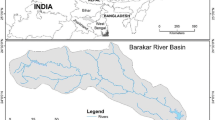Abstract
The fragile ecosystem of the Himalayas has been an increasing cause of concern to environmentalists and water resources planners. The steep slopes in the Himalayas along with depletedforest cover, as well as high seismicity have been major factors in soil erosion and sedimentation in river reaches. Prediction ofsoil erosion is a necessity if adequate provision is to be madein the design of conservation structures to offset the ill effects of sedimentation during their lifetime.In the present study, two different soil erosion models, i.e. theMorgan model and Universal Soil Loss Equation (USLE) model, have been used to estimate soil erosion from a Himalayan watershed.Parameters required for both models were generated using remotesensing and ancillary data in GIS mode. The soil erosion estimated by Morgan model is in the order of 2200 t km-2 yr-1 and is within the limits reported for this region.The soil erosion estimated by USLE gives a higher rate. Therefore, for the present study the Morgan model gives, for area located in hilly terrain, fairly good results.
Similar content being viewed by others
References
Bartarya, S. K.: 1995, Hydrology and water resources of intermontane Doon valley, Wadia Institute of Himalayan Geology, Dehradun, Journal of Himalayan Geology 6(2).
Bocco, G. and Valenzuela, C. R.: 1988, Integration of GIS and Image Processing in Soil Erosion Studies using ILWIS, ITC Journal, International Institute for Aerospace Survey and Earth Sciences, The Netherlands, pp. 309-319.
Das, D. C.: 1977, Soil Conservation Practices and Erosion Control in India–A Case Study, FAO Soils Bulletin, Vol. 33, pp. 11-50.
Das, D. D. C., Bali, Y. P. and Kaul, R. N.: 1981, Soil conservation in multipurpose river valley catchments. Problems, programme approaches and effectiveness, Indian Journal of Soil Conservation 9(1), pp. 5-26.
DeRoo, A. P. J.: 1996, Soil Erosion Assessment using GIS, Geographic Information Systems, in Hydrology, Kluwer Academic Publishers, Dordrecht.
Garde, R. J. and Kothyari, U. C.: 1987, Sediment yield estimation, Journal Irrigation and Power (India) 44(3), 97-123
Jain, S. K.: 1995, GIS Applications in Soil Erosion Studies, Annual Report, National Institute of Hydrology.
Jain, S. K.: 1997, Evaluation of catchment management strategies by modeling soil erosion/water quality in EPIC supported by GIS, M.Sc. Thesis (Hydrology), National University of Ireland, Ireland.
Kothyari, U. C.: 1996, Erosion and Sedimentation Problems in India, in Proceedings of International Symposium on Erosion and Sediment Yield, Exeter, U.K., IAHS Publication No. 236, pp. 531-539.
Morgan, R. P. C., Morgan, D. D. V. and Finney, H. J.: 1984, A predictive model for the assessment for the soil erosion risk, Journal of Agriculture Engineering Research 30, 245-253.
Philip, G.: Active tectonics in the Doon valley, Wadia Institute of Himalayan Geology, Dehradun, Journal of Himalayan Geology 6(2).
Rawat, J. S. and Rawat, M. S.: 1994, Accelerated erosion and denudation in the Nana kosi watershed, Central Himalya, India, Part I: Sediment load, Journal of Mountain Research and Development 14(1), 25-38.
Raymo, M. E. and Ruddiman, W. F.: 1992, Tectonic forcing of Late Cenozoic climate, Nature 359, 117-122.
Saini, N. K., Rath, M. S., Khanna, P. P., Mukherjee, P. K., Purohit, K. K. and Sreeram, V., Geochemical characteristics of Doon valley soils, Journal of Himalayan Geology 6(2).
Shrestha, D. P.: 1997, Soil Erosion Modeling, ILWIS 2.1 for Windows, Application Guide, International Institute for Aerospace Survey and Earth Sciences, The Netherlands, pp. 323-341
Singh, G., Chandra, S, and Babu, R.: 1981, Soil loss and prediction research in India, Central Soil and Water Conservation Research Training Institute, Bulletin No. T-12/D9.
Thakur, V. C.: 1995, Geology of Doon valley, Garhwal Himalaya, Neotectonics and coeval deposition with fault propagation folds, Wadia Institute of Himalayan Geology, Journal of Himalayan Geology 6(2).
Valdiya, K. S.: 1985, Accelerated erosion and landslide-prone zones in the central Himalaya, Concepts and Strategies, Gyanodaya Prakashan, Nainital, pp. 122-38.
Wischmeier, W. H. and Smith, D. D.: 1978, Predicting rainfall erosion losses: A guide to conservation planning, USDA Handbook No. 537.
Author information
Authors and Affiliations
Corresponding author
Rights and permissions
About this article
Cite this article
Jain, S.K., Kumar, S. & Varghese, J. Estimation of Soil Erosion for a Himalayan Watershed Using GIS Technique. Water Resources Management 15, 41–54 (2001). https://doi.org/10.1023/A:1012246029263
Issue Date:
DOI: https://doi.org/10.1023/A:1012246029263




